China today's main battle tank
The first-line armoured divisions in active service today within the Chinese People's Liberation Army are equipped with 2,500 Type 96 MBTs. The much upgraded Type 98/99s are in comparison only reserved to elite units of the army. The Type 96 is also a far away descendant of the soviet T-54A. The latter was adopted for mass production with the help of USSR back in 1959 and copied as the Type 59, then gradually improved over the years through the the Type 69/79 (mainly exported), the Type 80/88 (L7 derived 105 mm and brand new drivetrain) and eventually the Type 85 (that swapped the old hemispheric cast turret for a composite, welded one).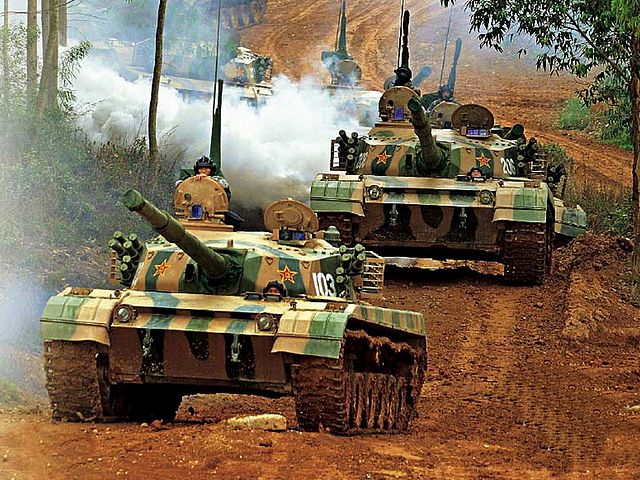
*Production 2077 as of mid-2016 declared alongside 814 Type 99s for a total of 7000 tanks overall. Through this lineage and shifting relationships with Russia and the West, technology transfers allowed Chinese engineers from the various institutes and research centers working with Norinco to provide an affordable, easy to maintain MBT which could cope with all the terrains and climates of a countrywide as a continent, while keeping pace with the technological advances of these countries. However, the great incentive behind its development was the revelation of performances by Iraqi Chinese-built Type 69/79s during the 1991 gulf war that sent a clear message that Chinese tanks were hopelessly outmatched by their western counterparts.
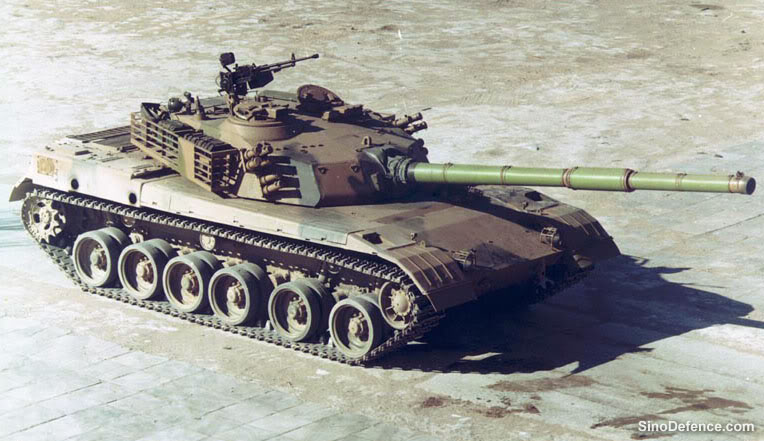
The Type 85-III prototype (credits sinodefence.com)
The Type 96 MBT is largely a transitional 2nd/3rd generation MBT which resulted from a long, pragmatic, and properly Chinese evolution and followed by the Type 96G in 2006 that set up a new standard for future upgrades. The importance of this tank by numbers and capabilities must not be underestimated. It has replaced completely all the previous types, now largely in mothballs and depots due to budgetary constraints. This is also the only Asiatic MBT produced in such numbers, and even if NORINCO halted the production it is now estimated to around 3000+, not comprising the exported derivatives like the VT-1A and VT-4 which are now rated in high esteem by many world experts.
Roots: The Type 85 (1985)
The Type 85 MBT was largely developed to catch the level of the T-72 and started over the Type 80 chassis that sported a brand new hull and modern drive train. All the efforts of the various research institutes resulted in the design of a brand new armour set for the hull and a brand new welded turret that definitely draw a line with the previous 1st generation cast turret models.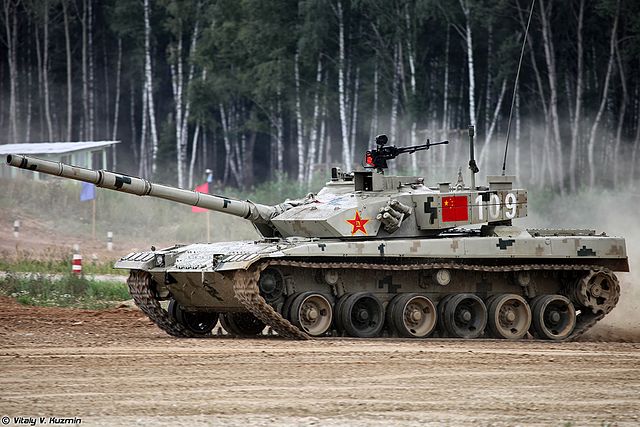
Type 96A at the Tank biathlon 2016 - notice the new light brownish digital camouflage The Type 85 turret remarkably mirrored the compact, hexagonal design seen on the T-72 and T-64, models that focused the attention of the engineers. So for the neophyte, there is little to remind its technical lineage, but appearance can be deceptive. The Type 85 entered service in 1989 and what followed was for China a new Freeze with the west, following the events of 1989 with students demonstrating for freedom of speech. Nonetheless, with new promises of exports with Pakistan to help finance more advances (Type 85H), the Type-85 IIM was developed in 1993 alongside the Type 90 and helped to combine several advances in firepower (the new 125 mm smoothbore gun and modernized FCS), and protection with a new ERA pack among others, while the Type-85 III is considered as one of the two direct ancestors of the Type 96. The Type 85 was not mass-produced (only around 800 estimated left NORINCO) but largely served as test-bed both for the development of the Type 90/96 and the Al-Khalid or MBT-2000 for Pakistan.
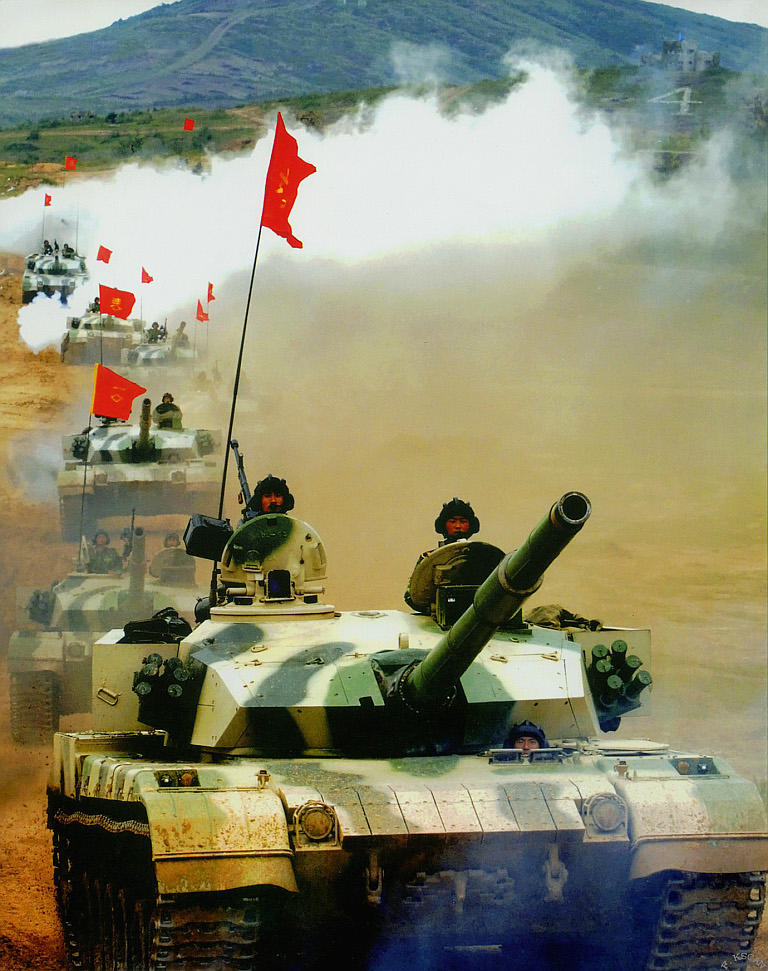
type 96Gs in maneuvers in the desert (sinodefence.net).
The Type 90 (1990)
The type was a separate development alongside Type 85 by the Beijing 201 Institute (China North Vehicle Research Institute) and the Inner Mongolia 617 Factory (Inner Mongolia First Machine Group Corporation or Norinco). The great leap forward was a rethinking of armour, with the design of a fully modular set of blocks for the frontal arc of the turret. These bolted blocks allowed to be repair easily or replaced when when more advanced composite armour are available, allowing rapid armour upgrades. other than this, the powerplant was left unchanged, as well as the drivetrain, although the hull was modified to include additional ERA blocks and the side skirts were upgraded.Type 90-I
This version was developed solely for export, and intended for Pakistan that then seek for a 3rd generation MBT. In this version the engine compartment was raised and modified to allow a much bigger engine to be fitted, the British Perkins Shrewsbury CV12-1200 TCA diesel already used in the Challenger 2. It was coupled with a French SESM ESM 500 automatic transmission (Leclerc). But due to the arms embargo following the 1998 Pakistani nuclear tests the project was halted and no further progresses were made.Type 90-II
Norinco engineers capitalized on this model to create another version using a purely Chinese engine. However, the 1000 hp power plant was relatively reliable in the southern the humid climate but failed to met meet both the required army standard for northern China which is rather arid, and Pakistan's relatively comparable desert climate. In short, all the niceties of such technologically advanced engine were not yet mastered.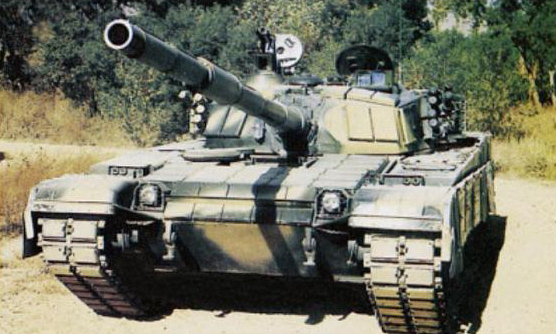
The Type 90-IIM
Type 90-IIM
On this prototype, China negotiated with Ukraine the delivery (since the relationships with Russia were still quite tense) of the 6TD diesel. With this engine, and even before any trials started, Pakistan was impressed enough to decide on paper to adopt this model already, named Al-Khalid. No less than 600 tanks were scheduled to be produced by the heavy industries Taxila in Pakistan until 2007 (with Norinco components), following by the MBT-2000 which is an upgraded variant. In all, Pakistan would produced some 600 Al Khalid of which at least 300 are in service with the Pakistani Army today. The design was tailored to be adaptable to multiple configurations of engine for export. Only three VT-1A (the export name of the MBT-2000) are in service with the PLAGF today for training.Design of the Type 96
Hull
The hull is based on the Type 85. It is entirely made of welded steel RHA, with a light recess to the rear to artificially increase the glacis front angle. The most characteristic point are the sides armored storage boxes or encased compartments blended in the upper hull. The hull sides are almost slab-sided overall, but these storage boxes add an extra layer of protection. Overall the general configuration does not change compared to previous models. The driver is located on the left hand side, with his own one-piece, rear-opening hatch and three periscopes covering the frontal arc. The central one could be swapped for an IR device, which was of short range on the basic Type 96 (max. 800 m field of vision). He also had an extra escape hatch under his feet. At the rear the raised engine deck counts six cooling grilles and engine louvres, while the two exhaust pipes are located on the right hand side. There is apparently no system to cool the fumes down or diminish the IR thermal signature.However the same soviet-style active protection system found on the previous Type 80/88/85 is kept: A device injecting diesel fuel on the hot exhaust pipes to create a smoke cloud. An automatic detection/suppression fire extinguisher is fitted both in the engine compartment and crew compartment. Like previous MBTs, provisions are made for extra external fuel tanks on the back panel (rarely shown on photos) and the usual unditching beam and towing steel cable. On the glacis front, the welded breakwater is removed to make room for ERA blocks fittings. Day and blackout headlights with armored covers are placed on each side. Generally there are 8 rows of 5 ERA blocks per row, from the turret ring to the beak protecting the whole glacis. The lower beak was protected by an extra 8 blocks to left the towing hooks free.
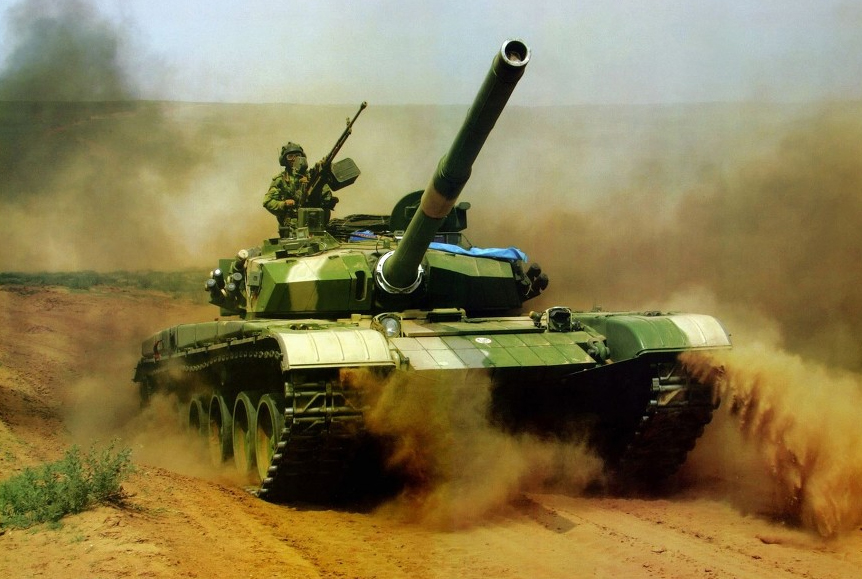
Superb photo of a ZTZ96A/G roaring in the North-western desert in the 2010s. Notice the absence of rubber side skirts. Sharing the same turret, the Type 98 can be distinguished by different roadwheels (more spaced on a much longer hull), six rubber side skirt panels and new composite side armour. (sinodefence.net)
Turret
The turret is similar to the Type 85, and of composite construction. It is octogonal in shape with a reduced front part which constitutes the mantlet and provision on the two outer faces for the large modular amour blocks. On the two other faces that linked with the turret rear sides, two banks of smoke dischargers are fitted, of varying configuration. Generally these are two banks of two and two of four (six in total per side). The turret rear sides are holding the large storage basket doubling as BAR-style slat armour to defeat RPGs. There is no storage at the rear but the turret is slightly elongated and fitted with fixings for the fording equipment and snorkel tube placed transversely. The commander cupola is located to the left hand side and gunner to the right.Protection
Type 96 used a welded turret already tested on the Type 85 but is the first tank in China to use a modular armor. On the front part of the turret are fitted three type 683 composite armour modules connected by bolts. They can be in effect quickly replaced when damaged or for upgrades, which is a highly flexible solution. According to "Contemporary China's weapons industry" these composite armour modules were studied by the 52 and 617 plants and developed over the Type 681 composite armour developed in China which used a "Special material + metal + composites" sandwich-type structure, able to defeat fin-stabilized projectiles and all sorts of shaped-charge warhead. At 2000 meters of distance the level of protection against APFSDS is estimated to be equivalent to 530 mm of homogeneous steel armour. This compares well with the Russian T-90 tanks but not with the M1A2 (700 mm), but the weight gap is such that this figure seems quite reasonable. According to NORINCO foreign trade data, China's newly developed FY series of ERA protection indicates an equivalent of the Russian "Kontakt-5" reactive armour level, fully proven against APFSDS-T rounds is equivalent to 300 mm of homogeneous steel armour. Part of the active protection is provided by the electrically-fired smoke mortars on either sides of the turret.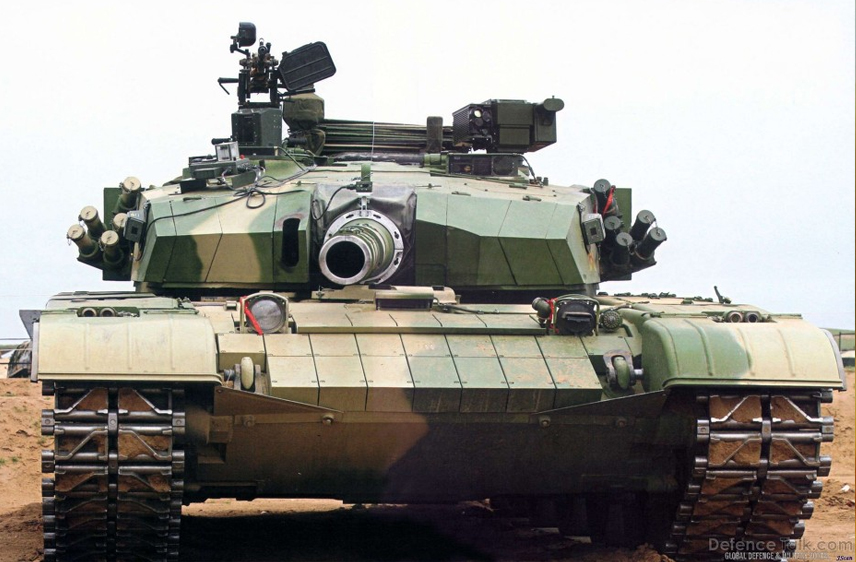
Type 99 face - Credits defencetalks.com - the turret design was essentially the same.
Armament
Compared to the Type 85 and 80/88, the Type 90/96 have all a new smoothbore 125 mm cannon, coupled with an auto-loader that spares the loader and contribute keeping the turret compact. The secondary armament was, as usual, a coaxial 7.62 mm LMG which had a 1,800 m range at 250 rpm, and a heavy 12.7 mm anti-aircraft machine gun mounted around the command cupola with a 2000 m range, respectively with 2,250 7.62 mm rounds and 500 12.7 mm rounds. No data is available to describe more precisely the auto-loader characteristics, but is known to have been developed from the Russian T-72 original auto-loader, and tested on the Type 88 and Type 85, and refined in the Type-85-III. It is capable of Shells selection, complete ramming, filling process of the larger rounds with separate charges tailored for the 125 mm smoothbore main cannon. Maximal rate of Fire is six round a minute. The new caliber derived from the Type 85-III offers to the Type 96 a wide range of ammunition compatible with Russian T-72 stocks, HEAT, HE, APFSDS, but also ATGMs (Russian-made Refleks anti-tank missiles). The HE is a versatile round with fragmentation effects against soft-skin vehicles and infantry, complementing the usual FRAG-E. Normal provision is 42 rounds of all types. The gun itself had a - 4 depression and + 12 degrees elevation.APFSDS: Muzzle velocity 1,730 m/s, armour penetration 500 mm RHA at 0° at 2,000 m. This is a 546.5 mm long, 7.34 kg in weight round, compatible with the T-72 tank gun according to NORINCO.
BK-27 HEAT: Triple-shape charge warhead, penetration value 600 mm of RHA at 0° at 2000 m
BK-29 HEAT: Triple charge, hard penetrator cap either tungsten or depleted uranium, tailored for dealing with reactive armour. Penetration value 550 mm of RHA at 0° at 2000 m.
Mobility
The Type 96 relies on the same modernized drive train of the previous Type 80/85/88 made of six lightweight road wheels each with its own independent torsion arm, and shock absorbers are placed in addition on the two front and one rear road wheels suspension set. The drive spocket, idler, return rollers and tracks are unchanged. Like the previous models, the whole drive train in protected by rubber skirts (six panels) to defeat RPGs. The type 96 relies for many years on the 12150ZL type V-12 cylinder water-cooled turbocharged diesel engine rated for 537 kilowatts (730 hp) at 2200 rpm. This power unit is derived from late 1980s Western (German) designs but no technical improvement was available when the wet put a ban on technology transfers after 1989. The Type 96 series could have been upgraded with the Domestic 85-III experimental 1,000 horsepower diesel but the latter was conceived for the export of foreign trade market and did not corresponds to Chinese PLA own specifications based on a wide range of climatic diversity.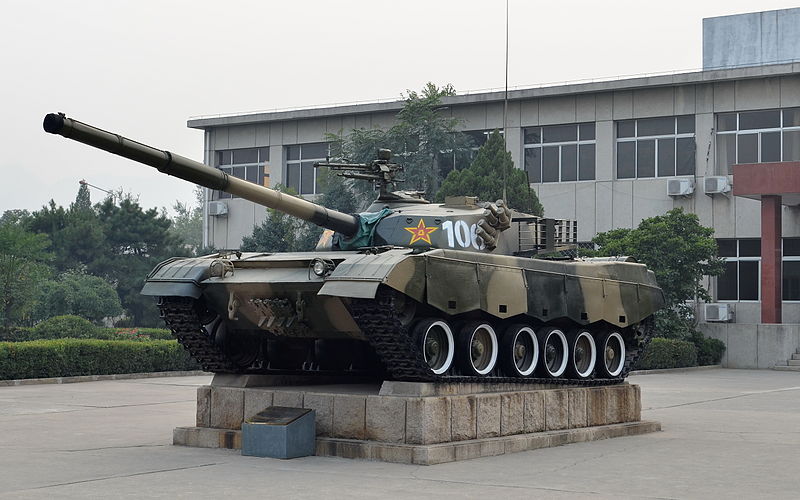
ZTZ-96 at the entrance of the Beijing tanks museum.
According to official data, the 12150ZL turbocharged diesel development was started in 1973 and the first prototype was tested in 1974, and has since gone through 13 years of successive improvements. From 1987 Reports and almost 17 years career with the Type 80, the engine is described as "rugged, reliable, durable, and easy to maintain", the easy maintenance has been the main factor of confidence according to PLA's doctrine point of view. This engine is basically derived from the Soviet B2 used on the T-54A which was adapted to the Type 59 tanks and reached the maximum of its possible technical evolution and refinements. This long experience and commonality helped to greatly reduce Pressure on the Logistics department which used a lot of spare parts shared bewteen the 12150ZL and 12150ZL-7 diesels. This choice also eased and streamlined maintenance training for the crew, mechanics, and proved extremely valuable on the economical standpoint in the long run, although for the Type 96G it was obviously not sufficient anymore. Field performances were as follows: Top speed 65 kph, climbing capabilities : Gradient 60%, side slope 40%, vertical step 0.8 m. it was found capable of crossing a trench 2.7 m wide, ford 1.4 m of water or 5 meters with preparation.
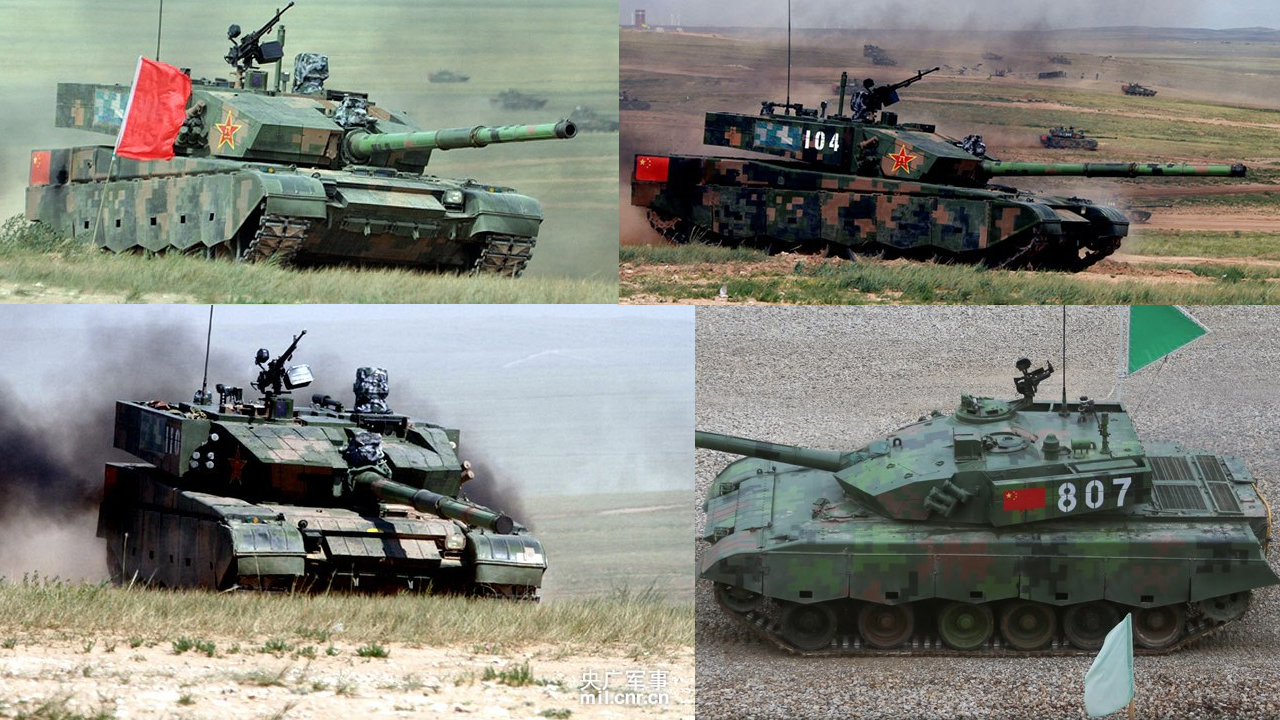
Comparison between the ZTZ99A2 and Type 96G.
The Type 96A/G (2006)
Overall improvements:
The Type 96A/G (sometimes called 96A sometimes 96G but any significant difference is hard to sort out) was officially presented in 2006 as a fully modernized model, featuring a completely revised turret armour suite apparently similar to the Type 98/99 MBT series. It holding a passive countermeasures system comparable to the Russian Shtora-1, which electro-optical jammers on either sides of the turret intended for adverse SACLOS command to line ATGMS as well as laser rangefinders and target designators. Another innovation is the use of a thermal imaging system with a powerful image intensifier for the gunner's sight and there is a new trans-fire control system which has automatic tracking system like western tanks, enabling a hunter-killer capability. On the front hull and turret a new domestic ERA set is fitted. This contribute to a far more accurate firing capability and protection standards of true 3rd gen. MBT, a leap forward compared to the previous Type 96. Night vision capabilities however the range of night/day low visibility fighting to extend from 800 to 2000 m compared to the previous model. Nothing was sure however about their fire-on-the-move capabilities back in 2006. It was listed in the known spec sheets of the Type 96G since as well as a laser suppression system.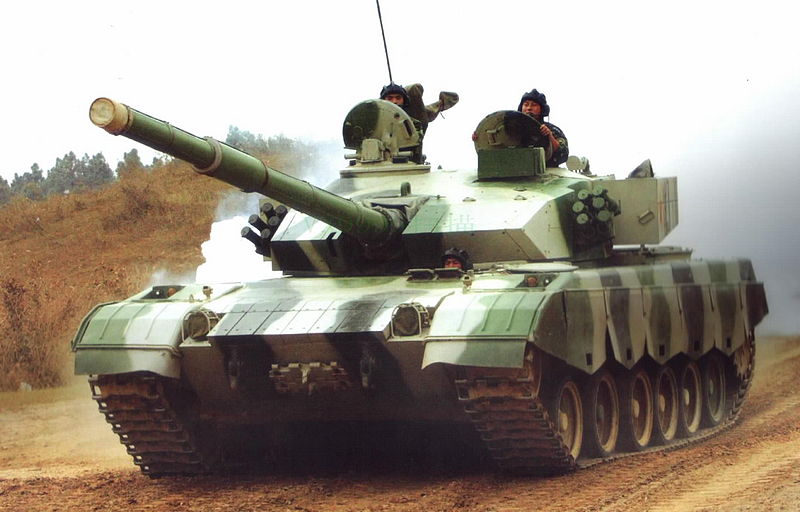
The Type 96A/G (Wikipedia)
Protection
Compared to the basic Type 96 the new protection is showcased on the turret front and sides with the installation of a new type of reactive armour modules. The Type 96G armor-piercing capability protection level equivalent jumped to 830 mm of RHA, with a "Kontakt-5" upgrade level comparable to the Russian T-90. According to US, German and Chinese reports from 1996 to 1999 of live fire testings, even using the latest M829A2 U.S. DU (depleted uranium) capped penetrators at 1,500 m distance, no effective damage can be made to a tank equipped with "Kontakt-5 "type ERA. This leverage the overall degree of protection of the Type 96G that is already equivalent to the "Dolly Parton" composite armour level of T-72. The Type 98/99s are not better protected in this occurrence, but put the cursor over mobility which is the Achilles heal of the Type 96G. Comparatively to its relatively lightweight and low-profile hull - especially compared to the M1A2 - these protection level is quite honorable. There is also a collective NBC and slight over-pressure inside the fighting compartment.Mobility
That was paid in return by a considerable increase in weight (which rose by 3 tons) while the power plant did not follow on the previous series, and therefore traduced itself as a loss in mobility. For much sources however the Type 96G power plant was upgraded to 1000 hp. Basically, this engine is derived from the one in use on the 85/88. The Type 96A/G 44 tons of combat weight for its 730 hp traduced as only 16.6 hp/t, while on the Russian T-90 there is 840 horsepower available to move 46.5 tons, resulting in a 18 hp/ton ratio, and 24.1 hp/ton on the Type 96A/G. Field mobility, climbing capabilities, accelerations, are all improved on the Type 96G. There is still room for improvements for the old engine though, such as the steering mechanism planetary gearbox reliability, or increasing the hydraulic booster devices to reduce the physical strain on the driver.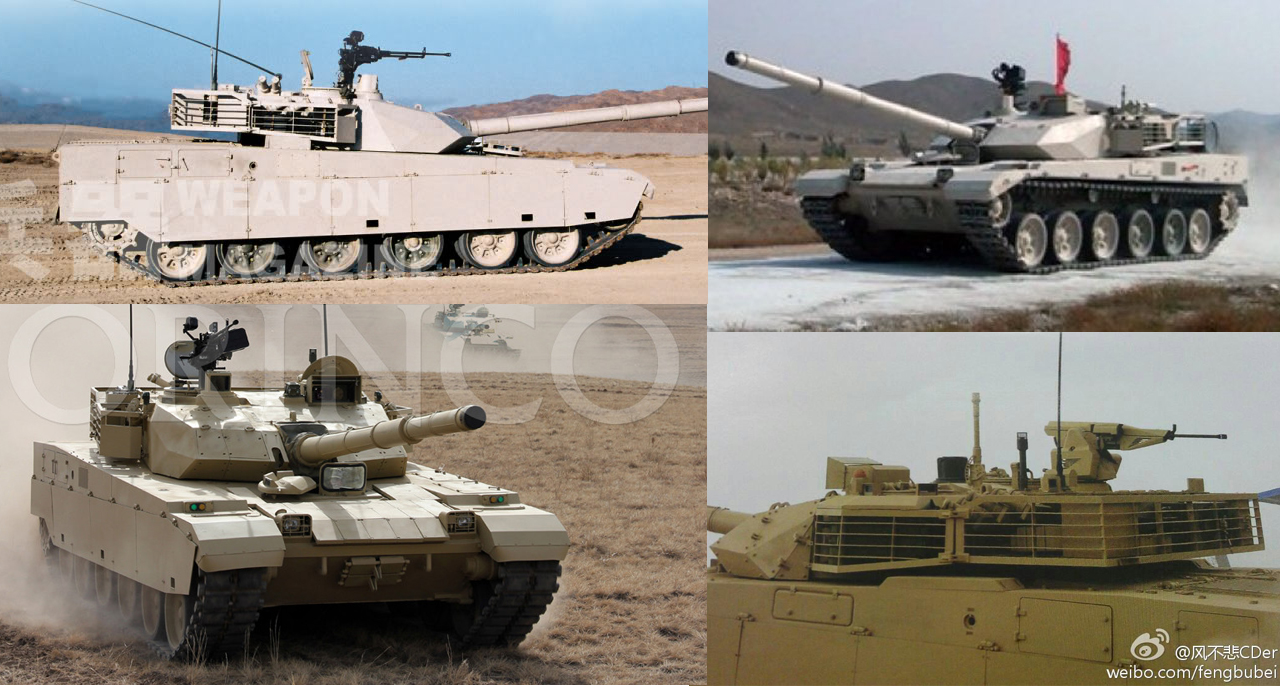
Visual recognition of the VT1A/VT-4A export tanks from Norinco, its most recent products.
Exports
The only true foreign customer of the Type 96 is Sudan, that purchased some 200 Type 96A. These were the only of the type actually blooded in combat, at Heglig in 2012 when up against South Soudanese T-72 MBTs, apparently scoring 4 kills for no losses.Pakistani Al Khalid
Assembled at the Heavy industries Taxila with Type 90-IIM/MBT 2000, around 500 Al Khalid MBTs are in service, and were displayed in Saudi Arabia among others. Potential customers for the Al Khalid includes Peru, but later the deal was blocked by claims of foreign trade issues of sensitive patents from Ukraine (the main engine). Sri Lanka purchased 22 Al-Khalid.
MBT-2000 exports
Bangladesh purchased 44 MBT-2000s delivered by Norinco in 2012-2013. Myanmar also ordered some (unknown numbers).
VT-1 to VT-4 exports
The VT-1/VT-2 and VT-4 are export versions of the MBT-2000 mixing featured of the Al Khalid and Type 96A/G. By now only Morocco purchased the VT-1, as 150 were ordered and delivered in 2011-2013.
Active service
The Type 96 entered service in 1997 in the PLA, gradually replacing all the upgraded Type 59s in service with first-line units and later on, in turn the Type 88 that had been recently fielded. The Type 96 was believed by Western military observators to be called the Type 88C, and the export version the Type 90. The latter never entered service with the PLA but served as test beds and indeed mostly for export versions. The irony of it was the latter was more powerful and fast than the Type 96. When the Type 96A/G was introduced in 2007, it in turn replace gradually some elite front-line units that were not equipped yet with the Type 98/99. Now that the latter are in sufficient numbers, the Type 96A/G are now considered for the best regular armored units while the Type 85/88s are kept for reserve units, training and peacetime depots. With the addition of these tanks, plus the Type 80s, Type 79 and Type 59-III still serviceable by conscripts, it is estimated that the PLA can mobilize up to 5000 tanks.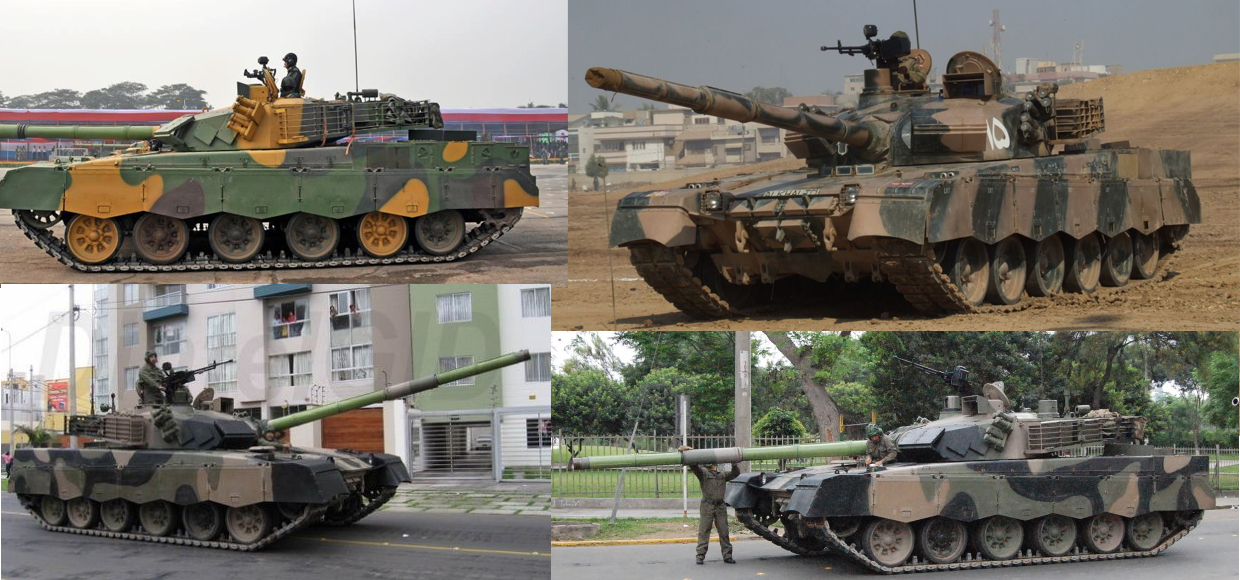
Visual recognition of the Al Khalid/MBT-2000. Respectively Bangladesh (top left), Pakistan (top right), and Myanmar.
The Type 96G formed the backbone of the front-line Northern units alongside the Type 98/99 that are considered only for the elite units. It is in a sense a similar "two-tanks" strategy that is preferred in Russia too. The planned retrofitting of the Type 96 is currently under way, making the whole active units equipped with a 3rd generation MBT that this time compare well with both Western and Russian tanks of the
T-80/90 generation. In any case of a conflict with South Korea or Japan which both are fielding some state-of-the-art MBTs, the Type 99s would be opposed instead, since the
K1 and
Type 10 (which are extremely costly) are few in numbers. Although the production of the Type 96 was reportedly ceased in 2006, it was restarted by 2007-2010 for the much improved Type 96G or ZTZ-96G. However it must be said that the budgetary attention of the government clearly shifted to the navy and air force in the last decade (2005-2015) gradually decreasing the allocations to modern equipment for the PLAGF. In consequence no more modern night vision systems or hydraulic active suspension are planned yet to equip the fleet of Type 96s.
China showcased the Type 96A in a Russian tank "biathlon" in august 2014, comparing well with Russian T-72Bs, but came third, earning respect for its advanced weapons, excellent armour and rapid fire capabilities, but failed its mark overall due to be noteworthy under-powered. The size of the hull is still too cramped to mount a 1000+ engine or a comparable power plant to the Type 99. But what the still untested Type 96 lacks in mobility, it compensate largely by good overall characteristic in firepower and protection, that are excellent for its overall weight especially compared to much heavier Western tanks of the 60-70 tons range.
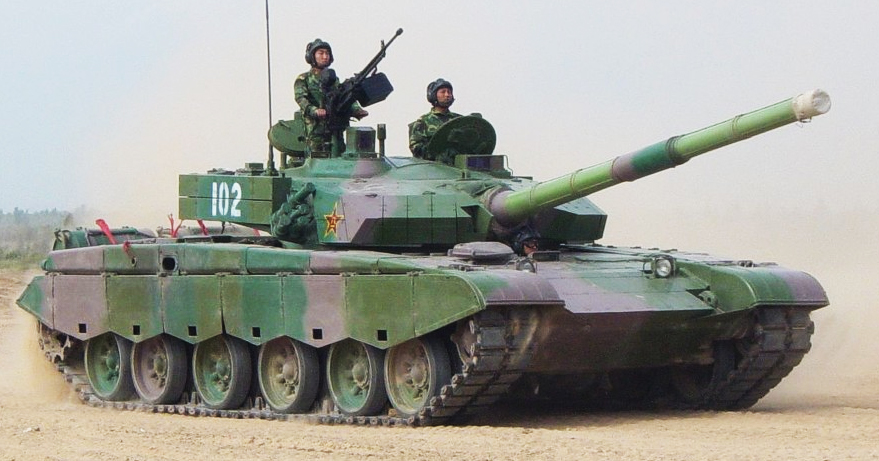
Type 99 in the Northern Desert. The Type 98/99 is a much evolved version of the Type 96A/G
Links on the Type 96
The Type 90/96 MBT on wikipedia...
The Type 96 on military-today.com
Type 96 on armyrecoignition.com
The very close Al Khalid MBT on Wikipedia.
Additional photos (Chinese website).
Gallery
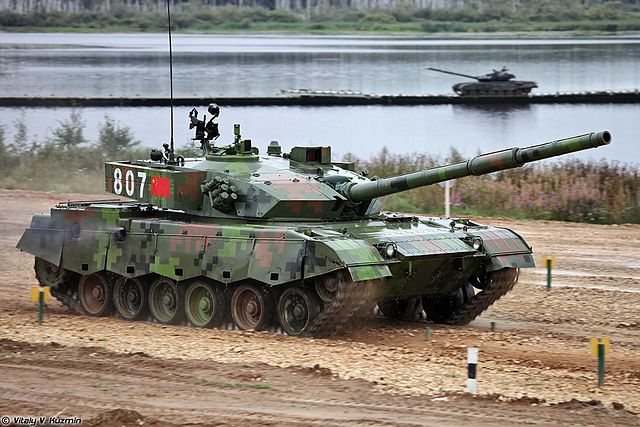
Type 96A at Tank Biathlon final 2014
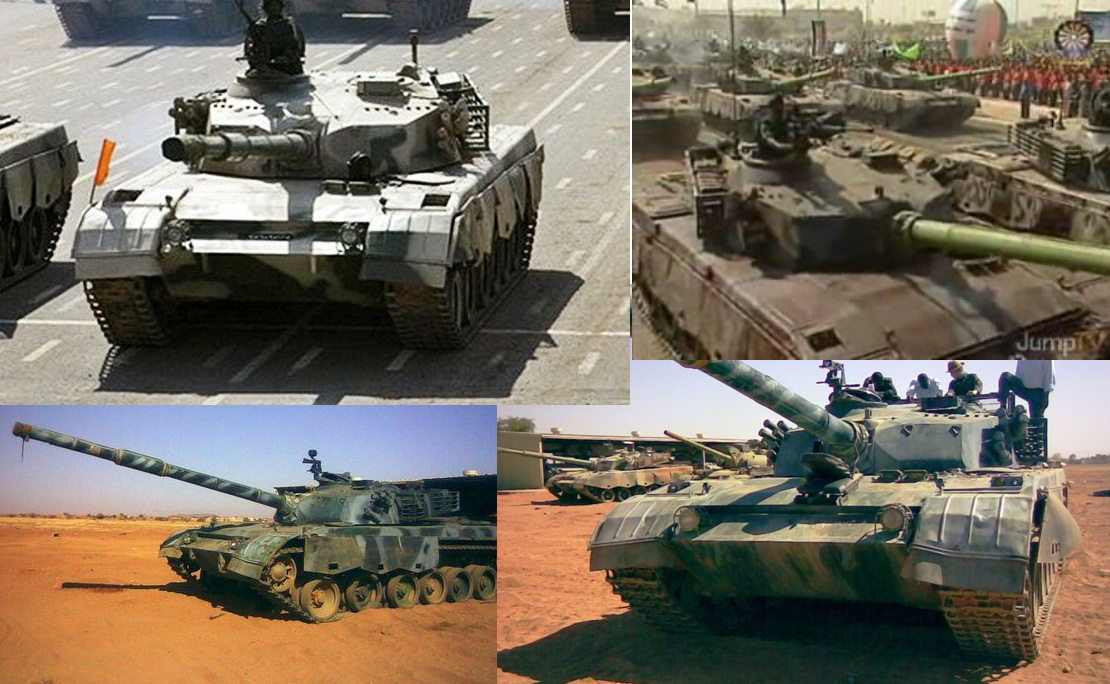
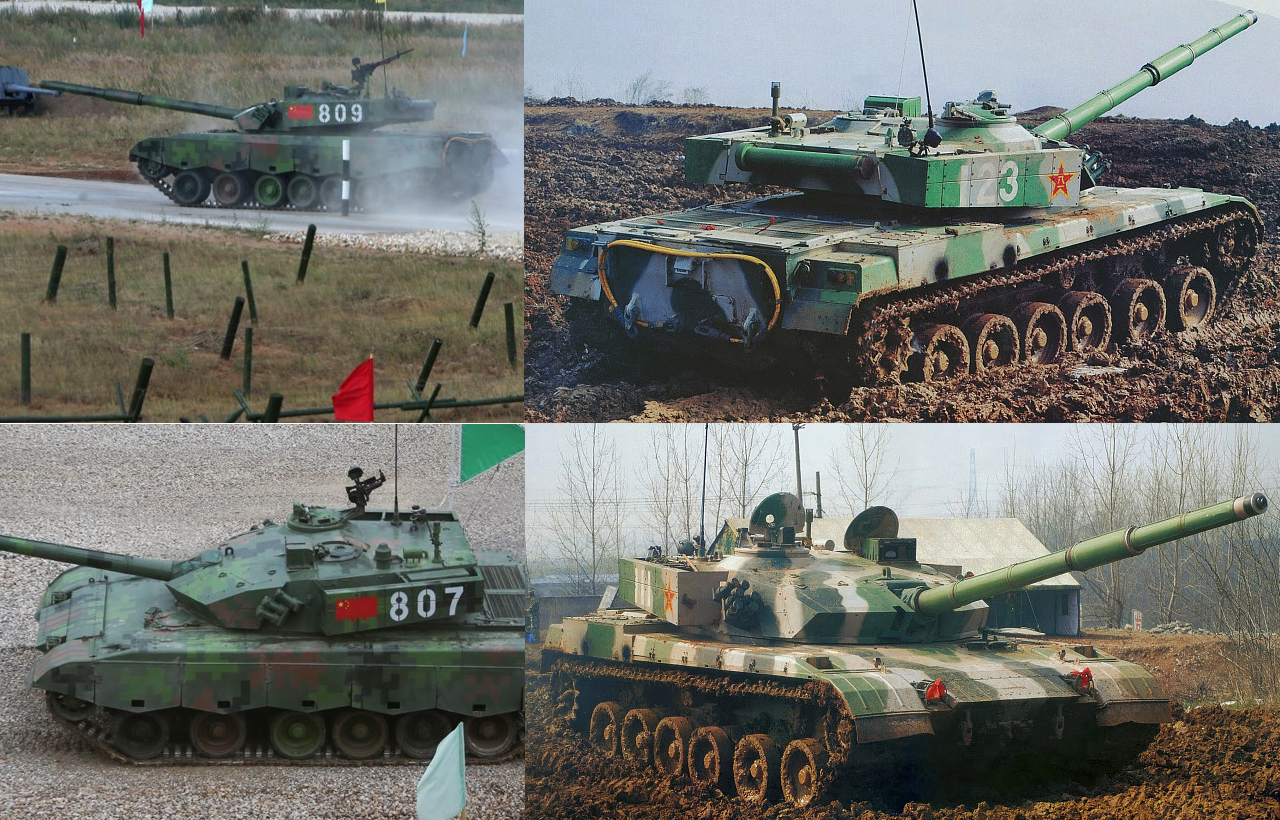
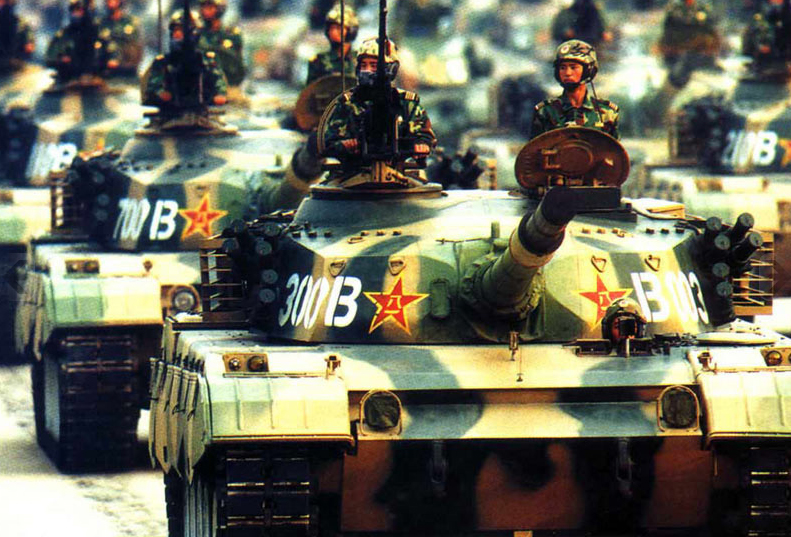
Chinese Type 96 (ZTZ-96) MBT specs. |
|
Dimensions |
10.28 (oa) x 3,45 x 2,3 m hull (xx fts) |
| Total weight, battle ready : | 43 to 48 long tonnes fully loaded |
| Crew | 3 (Commander, Gunner, Driver) |
| Armament | 125 mm SB Type 90, 45 rounds. AA Type 85 12,7 mm HMG. 7,62 mm LMG coaxial |
| Armour | Classified. ERA, composites, modular. |
Propulsion |
Norinco Turbodiesel 780 hp (582 kW) P/w 18 hp/tonne |
| Top speed | 65 km/h (40 mph) |
| Range | 400 km (250 miles) |
| Suspension | Torsion bar |
| Total production | Around 3000+ estimated as of today. |

Type 85 For comparison. The Type 96 reused the chassis and modular armour concept of the Type 85

Type 85-III MBT, With the IIM this model pioneered the new 125 mm smoothbore gun.

Type 96 (ZTZ-96) of the first serie now on display at the Beijing tank museum. This early model shows white painted rimmed roadwheels and probably was showcased in a annual revolution parade. At least 1,500 of this first serie was built until 2006.

Type 96 in manoeuvers.

Type 96 in maneuvers (another one).

Type 96A of the Chinese PLA from the early production. The digital camouflage was not the norm yet.

Type 96A1 (1995) in maneuvers in the 2010s.

Type 96G (1996) in joint exercizes for counter-terrorism in august 2014.

Pakistani Al-Khalid, derived from the Chinese Type 96IIM

Myanmar Al Khalid in 2014.

Bangladeshi MBT-2000.

Sudanese Type 96 MBT, according to a TV parade footage and photos.

Moroccan Type 96 VT-1A. At least 54 VT-1A are in service with the Royal Army of Morocco, and much improved compared to the average T-72, parallel to the T-80UM2, with combination protection of Composites and ERA and Western electronics. The model is quite secretive and photos are all but impossible to provide, however a relation is made with Norinco's latest export model VT-4/MBT 3000 showcased in a desert tan livery.

Norinco VT-4 MBT-3000 (2015) export main battle tank, mostly intended for the middle east and Southern Asia.

Modern Tanks
Modern MBTs posters

Denel Bagder (2018)

Type 16 MCV (2016)

Gepard 1A2 last rounds 2011

SANDF

Russian AFVs

Main Battle Tanks
